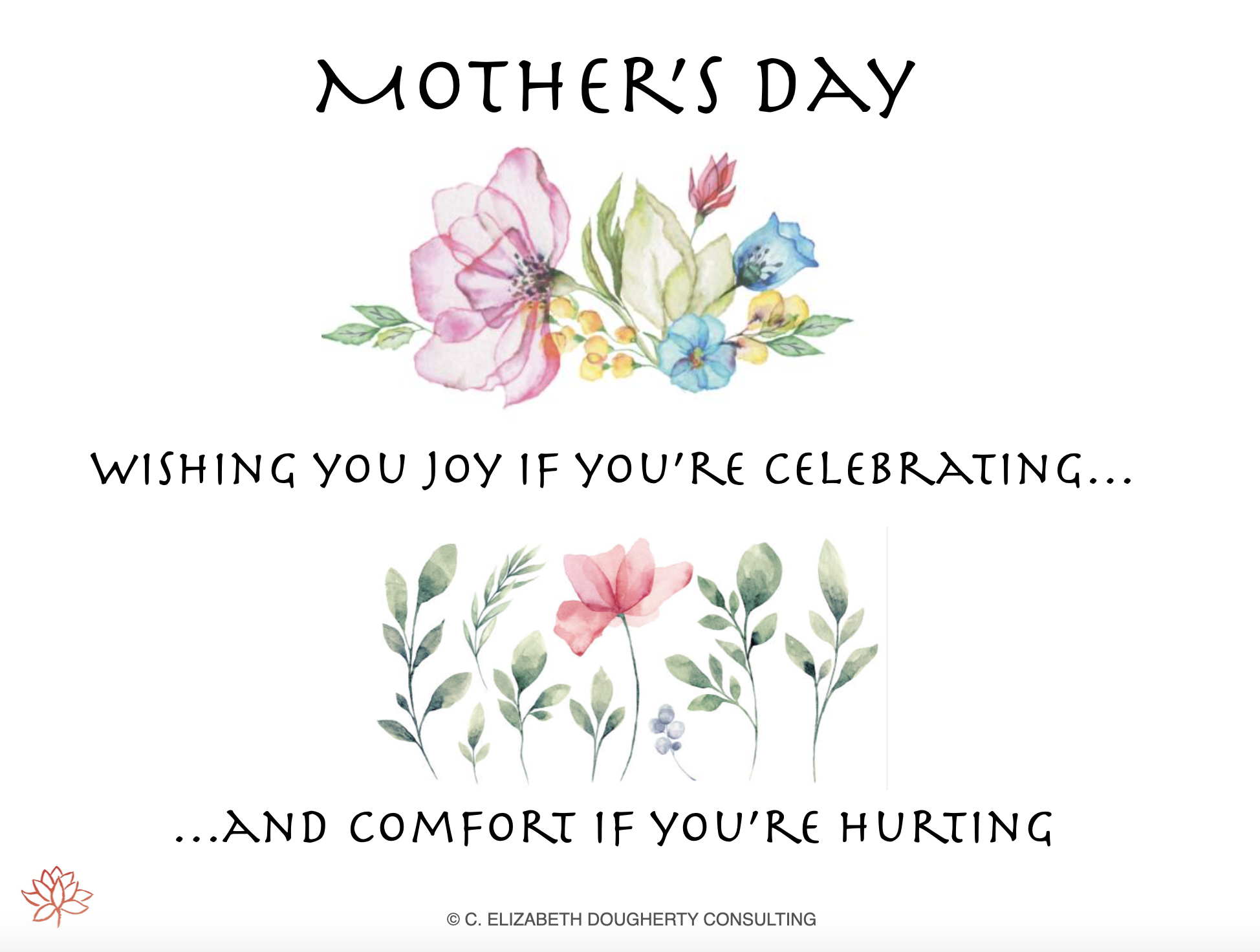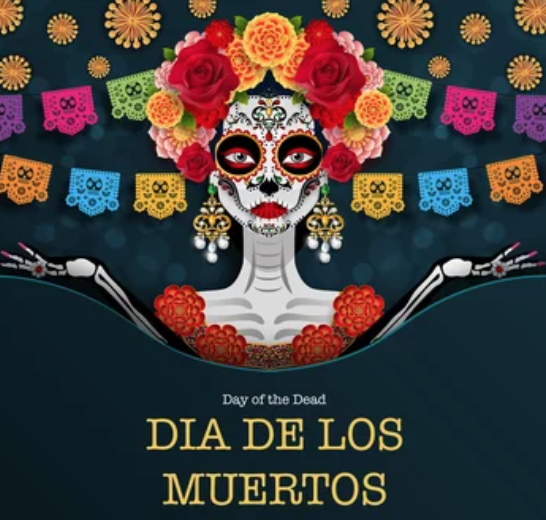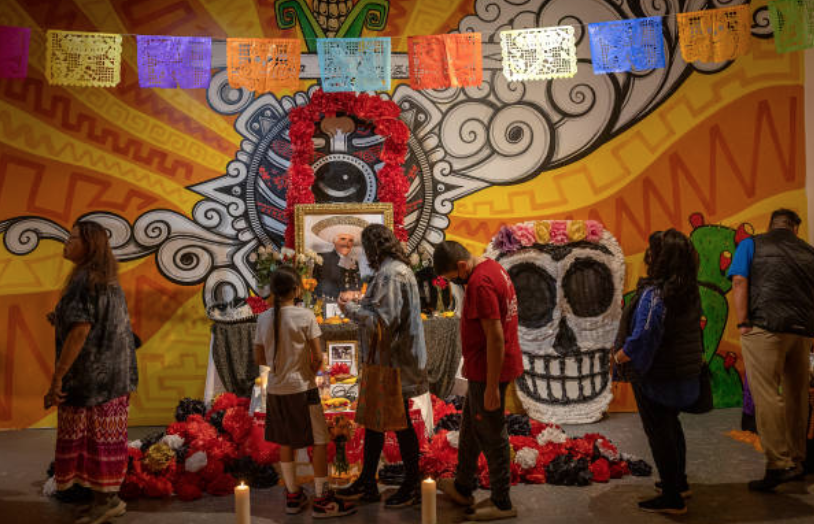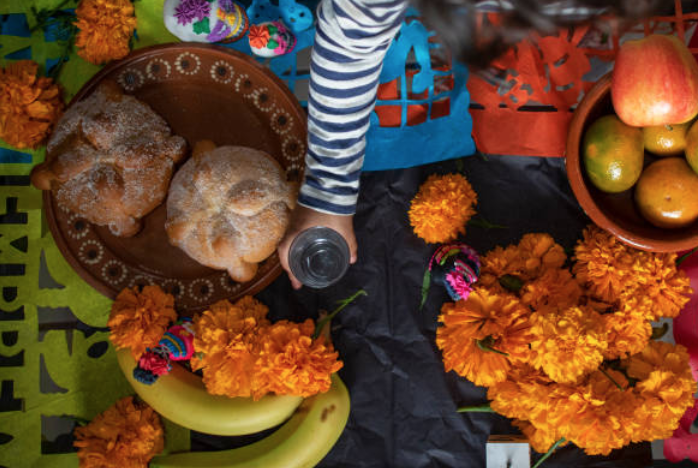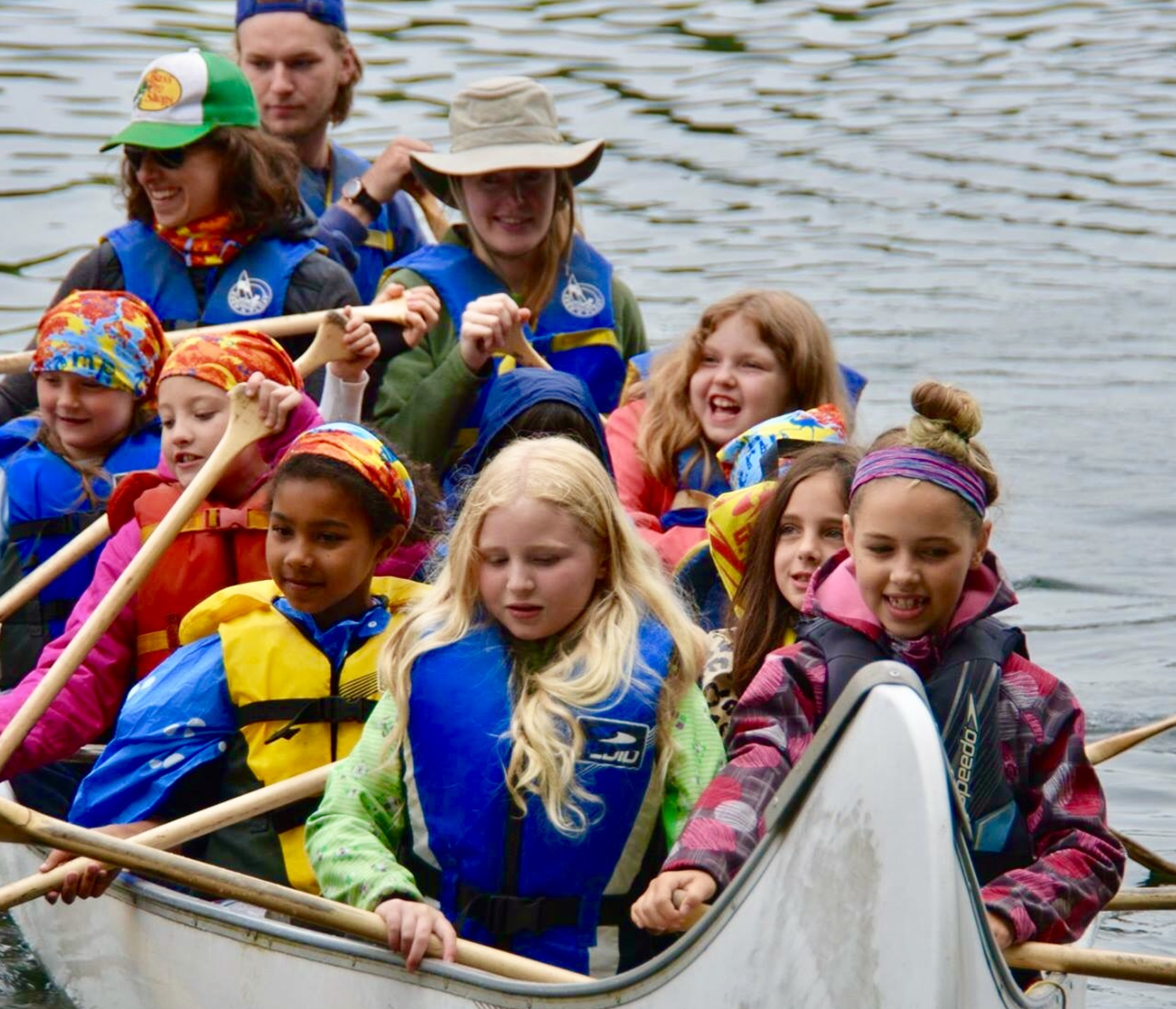Thinking of everyone on Mother's Day, in a multitude of ways... for all this day means for you, and for all that it holds, sending love and light.
Wishing grace and peace. ❤️
Día de Los Muertos: A Time to Grieve & Remember
Day of the Dead is a rare holiday for celebrating death and life. It is unlike any holiday where mourning is exchanged for celebration. Day of the Dead is a holiday to remember loved ones by sharing a meal with them as one would when they were alive.
Calaveras (Skulls) are ubiquitous during Day of the Dead. The skulls are often drawn with a smile as to laugh at death itself. They take many forms such as sugar candies, clay decorations, and most memorable: face painting. Sugar skulls are decorated and placed on ofrendas (altars) of loved ones. Marigolds are believed to be the pathways that guide the spirits to their ofrendas and they symbolize the beauty and fragility of life.
Dia de los Angelitos (Day of the little angels) starts the holiday at midnight on Nov 1st, where the spirits of all deceased children are believed to be reunited with their families for 24 hours. Families construct an altar, known as an ofrenda, with the departed child’s favorite snacks, candies, toys, and photographs to encourage a visit from their departed children. The names of the departed children will often be written on a sugar skull.
At midnight of the following day (November 2nd), the celebrations shift to honor the lives of the departed adults. The night is filled with laughter and fun memories, much like the night before. However, the Ofrendas take on a more adult-like theme with tequila, pan de muerto, mezcal, pulque and jars of Atole. Families will also play games together, reminisce about their loved ones, and dance while the village band plays in their town
The next day is the grand finale and public celebration of Dia de Muertos. In more recent times, people come together in their cities, dressed up with Calavera painted faces (Skeletons) and have parades in the streets. Cemetery visits are also common on the last day as families will go to decorate the grave sites with Marigold flowers, gifts, and sugar skulls with the departed’s name on them. It’s customary to clean the grave stone and restore the color.
Source: https://dayofthedead.holiday/
Do you know a grieving child or youth (aged 6-17) who could benefit from support?
Do you know a grieving child or youth (aged 6-17) who could benefit from support?
Am proud to be the new Clinical Director for Camp Erin Hamilton and want to share information regarding this extraordinary free camp.
Camp Erin is a FREE weekend bereavement camp (held annually in June) for children and teens ages 6-17 who are grieving the death of someone close to them (parent, caregiver, sibling). Campers participate in fun, traditional camp activities combined with grief education and emotional support, led by expert bereavement professionals and trained volunteers.
The following short videos capture Camp Erin Hamilton and highlights some of the kids and teens sharing the brilliant range of experiences that both normalize their thoughts and feelings and further empower them to cope with grief and loss.
If you know a grieving child or teen (6-17 yo) who would benefit from this experience, camper applications are now being accepted. Camper applications are due March 26th.
For more information, please watch the following video, or visit Dr. Bob Kemp Hospice or https://kemphospice.org/camp-erinfor details and application forms.
How the fear of dying taught me how to live
"Live. Put your phone down. Talk to the person in front of you. Hold the door for people. Smile if someone catches your eye. Say thank you. Say please. Give hugs. Compliment people. Compliment yourself. Love yourself. No one will remember what size the pants are you are wearing but they will remember the way you walked in them. So walk softly. Speak boldly. Love gently. Laugh loudly. Call someone if they cross your mind. Allow yourself to be happy for others, and most importantly allow yourself to be happy for yourself, through every stage and step of your life. Be happy. Life doesn't have to be perfect for it to be perfect."
“We know nothing about what is next” — Lessons on Loving & Losing a Child.
"I cannot control their world, nor prevent them from all harm. All I can do is try and focus on the now. Focus on what matters... And love them. I can love them in every way I know how."
Source: “We know nothing about what is next”—Lessons on Loving & Losing a Child.
Camp Erin: Where Children and Teens Learn to Grieve and Heal
Am honoured to volunteer with Camp Erin. It is indeed a remarkable community and one that nurtures capacity in children and youth to grieve the death of a loved one.
"Children and teens ages 6-17 attend a transformational weekend camp that combines traditional, fun camp activities with grief education and emotional support, free of charge for all families. Led by grief professionals and trained volunteers, Camp Erin provides a unique opportunity for youth to increase levels of hope, enhance self-esteem, and especially to learn that they are not alone.
Camp Erin is offered in every Major League Baseball city as well as additional locations across the U.S. and Canada. The Moyer Foundation partners with hospices and bereavement organizations to bring hope and healing to thousands of grieving children and teens each year.
Camp Erin allows youth to:
- Tell their story in a safe environment
- Process grief in healthy ways
- Meet friends facing similar circumstances
- Learn they are not alone
- Build a tool-box of coping skills
- Honor and memorialize loved ones
- Have fun!"
Source: Camp Erin. The Moyer Foundation
For information on Camp Erin locations in Ontario, please visit: Camp Erin Hamilton; Camp Erin Toronto; Camp Erin Eastern Ontario; Camp Erin Montreal
Looking Death in the Face
"We tend to defer the question of living or dying well until it’s too late to answer. This might be the scariest thing about death: coming to die only to discover, in Thoreau’s words, that we haven’t lived."
What people talk about before they die
“I visit people who are dying -- in their homes, in hospitals, in nursing homes. And if you were to ask me the same question -- What do people who are sick and dying talk about with the chaplain? -- I, without hesitation or uncertainty, would give you the same answer. Mostly, they talk about their families: about their mothers and fathers, their sons and daughters.
They talk about the love they felt, and the love they gave. Often they talk about love they did not receive, or the love they did not know how to offer, the love they withheld, or maybe never felt for the ones they should have loved unconditionally.”
Starting the Conversation: Death Cafe debuts in Burlington.
Tell someone you’re headed to a Death Café and no doubt their expression morphs into something between bewilderment and abject horror.
Odd words to toss together, and the name conjures up all sorts of somber, gloomy thoughts.
But Death Cafes are not morbid, depressing places, nor are they gathering spots for zombies. ‘Patrons’ don’t dress in black or ghoulishly discuss death while sipping tea.
Death Cafes are, in fact, respectful spaces where people of all ages can congregate to chat informally, often with complete strangers, about death and dying.
And who would choose to do that?
As it turns out, quite a few people; enough so, that there was a waiting list for the first ever Burlington Death Café last week at city hall.
The “very brave souls” and “trailblazers” - as organizers called attendees - ranged in age from their 40s to 80s.
Death Cafes are based on an “international movement” that originated in the UK and they are designed to begin a conversation about an uncomfortable, often taboo, subject – death.
There is no agenda or objectives at Death Cafes,” explained Roxanne Torbiak, of The End Game, which partnered with Carpenter Hospice to present the event. (Originally scheduled for the grounds outside city hall but moved indoors because of sweltering temperatures)
“It is simply a conversation that happens over coffee, tea and cake. Interesting conversation and laughter is guaranteed,” she said.
Among participants at the local Death Café were those whose professions routinely deal with death, but there were others from all walks of life and faiths who simply wanted to share and listen, people who felt the initiative an important conduit in opening up a very important discussion in the city.
“It’s really an introduction to the community. We want to create awareness and offer safe spaces for people to come together and talk about dying and death,” said C. Elizabeth Dougherty, a hospice palliative care social worker and educator.
“We want to reach out to everyone, all ages, and normalize it for people, whether they’ve been diagnosed with a life-limiting illness or whether they’re living healthy, fruitful lives.
“We want to create safe spaces for people to come together, to talk about their fears, their questions, their concerns, share their experience and really normalize this conversation.”
In their respective jobs as minister and palliative care consultant, Joel Bootsma and Villy Simonetta are all too familiar with death.
“Some people are very grounded in faith and meet it with courage, even joy; some with fear or worry,” said Bootsma, a Christian Reform Church minister, who was “interested in finding out what the community is wrestling with over this issue.”
As witness to extremes in how people deal with dying and death, Simonetta loves the idea of taking that fear out of death.
“It is part of life. It’s a beautiful experience when we’re born and as we go through the journey of life, it’s something we’re facing so let’s face it the best way we can, spiritually, (and) with love (and) compassion,” said Simonetta.
“I’ve seen some incredibly beautiful experiences where families are prepared; they’re very spiritual and it’s an intimate bonding time. Whereas some families struggle so much, they don’t want to let go and I struggle with that too because I see their struggle. You’re trying to support them in that whole process.”
In Buddhism, it’s about making death peaceful and quiet so one can let go of this world easily, commented Deborah Klassen, centre director of a Tibetan Buddhist Centre.
Participant Ann Dion was “privileged” to have been present for her husband’s, mother’s and mother-in-law’s death and
she feels strongly that the topic needs to be open and shared.
“We can’t be frightened because it’s there, it’s not going away,” said Dion. “(It’s like) If you don’t talk about it, it’s not going to happen.”
The Death Café was a natural supplement to Carpenter Hospice’s new Compassionate City Charter, said Bonnie Tompkins, Carpenter’s community health coordinator,
The hospice has based its charter on a UK model, and worked closely with the city to create “a framework of 12 social changes” to put Burlington on the path towards being a more compassionate city, said Tompkins.
“It’s all about building capacity in the community to support people because the reality is, the population is aging and the medical system can only do so much,” said Tompkins.
Many people don’t realize that healthcare professionals aren’t given training and education on dying and death and how to care beyond the medical model, or how to have those intimate, essential conversations about the psychosocial impacts of dying and death, said Dougherty.
“It’s about encouraging and empowering people to have these conversations with their families, friends and healthcare providers about advanced care planning, and their values and wishes for end of life care, said Dougherty, who co-founded The End Game, with Torbiak to provide professionally facilitated education and training sessions to normalize living and dying.
There is the demystifying piece to the movement, but the charter is also about embedding with community organizations to build bridges and links, said Tompkins.
“These conversations are so timely too because we know that only 16-30 per cent of Canadians actually have access to hospice palliative care services, so certainly funding and access is a concern,” said Dougherty.
Thankfully, she added, the quality of living and dying is on the national landscape, so it’s an especially important time to have these conversations, to raise awareness, and build a groundswell of public support.
Both Tompkins, who was sole caregiver for her terminally ill partner, and Dougherty, who has been immersed in palliative care for 17 years, said their experiences have taught them that open communication with loved ones is critical.
“Families are incredibly conflicted and very much wanting to be open and honest with each other, but the fear of not knowing what to say, or how to say it, or just the worry about the sadness. …denial is an incredible coping strategy for many people,” said Dougherty.
“The families I see that manage best certainly are those that have those open conversations, admittedly difficult conversations. It’s ok to be sad, it’s okay to be angry, it’s okay to be frustrated but it’s important to share what’s on your mind,” said Dougherty.
Last week marked the first Death Café in Burlington, but it’s certainly not the last, said Dougherty.
At the launch of the Compassionate City Charter this fall, organizers hope to have two simultaneous Death Cafes on Oct. 8, which happens to be World Hospice Palliative Care Day.
“We’re just getting started; we’re starting a revolution,” smiled Dougherty.
#Dying is Inevitable. #Living is Not. "#Love is Stonger Than #Death" Rest in Awesome Esther.
"Wayne Earl reveals the power of living and loving life by sharing the wisdom of his daughter, Esther Earl, who lost her battle with cancer just before her 16th birthday. Esther's courage, positive spirit and hope for the future transformed all who knew her. She showed the world what it meant to live life before death (via her well known vlogs and blogs) and that love is the engine of life. Esther Earl shared her spark of possibility with great generosity and was the inspiration for author John Green's #1 New York Times bestseller, The Fault In our Stars.
Wayne Earl recently authored the compelling life story of his daughter, Esther Grace, who succumbed to cancer shortly before her 16th birthday. Before she died, a deepening friendship with her favorite author, John Green, greatly encouraged her. The friendship also inspired Mr. Green, most notably in his writing of the world- renowned novel, The Fault in Our Stars, which he dedicated to Esther. The Earl Family founded the non-profit organization, This Star Won't Go Out, to help ease the financial burdens of families caring for children with cancer."
How We #Grieve: the Messiness of #Mourning and Learning to Live with #Loss. @meghanor
“It’s not a question of getting over it or healing. No; it’s a question of learning to live with this transformation. For the loss is transformative, in good ways and bad, a tangle of change that cannot be threaded into the usual narrative spools. It is too central for that. It’s not an emergence from the cocoon, but a tree growing around an obstruction.”
A #Daughter Pays Homage to Her #Parents With an Intimate Look at #Love and #Loss. @nancyborowick #hpm
"One can only truly understand and appreciate life when faced with one’s own mortality. Nobody wants to talk about death, but it is one of the only things that is certain in life, so an awareness of this finitude allowed my family to take advantage of the time we had left together. “Cancer Family, Ongoing” is the story of family, looking at the experiences of two parents who were in parallel treatment for stage four cancer, side by side. The project looks at love and life in the face of death. It honors my parents’ memory by focusing on their strength and love, both individually and together, and shares the story of their final chapters, which came to a close just 364 days apart from one another."
The "On Coming Alive" Project. #Grief. @lexibehrndt #oncomingalive
"We believe that we are meant to come alive. This doesn’t mean we’ll be without pain. This means that we’ll face the pain, looking it in the eye, feeling it, acknowledging it, never faking it, but embracing life for what it is, a coexistence of the deepest sorrows and the deepest joys. We want to be alive to feel both, because we know that if we hide from the pain, we often also hide from true, deep joy, from freedom, from love and life.
We believe that we come alive as we mend, but we also come alive when we reach up and reach out.
We want to dig down deep and muster the grit within us, reach out our hands, and pull one another to the light, because we don’t believe that we’re meant to always live in the darkness."
It’s worth it: #Love in the face of #Death. @lexibehrndt
"It’s a painful thing losing someone you love. It wrecks you at your very core. It shatters you, as they take a piece of your heart with them as they go. It is earth-shaking and dream-crushing and horrible in every way imaginable.
And it is worth every single second— every beat of their heart, every whispered prayer, every ounce of love given, every time you held their hand, every tear shed, every smile, every kiss, every lullaby and every single time they looked at you with soulful eyes, and told you in their own way, 'I love you, too.' They are worth it all.
Take it from me.
Choose the harder path. Love until you feel like your heart has given all it has, and then give a little more."
Looking Forward. ~ PhotoGrief. #Grief #Bereavement
Photos by Jimmy Edmonds
“These are montages that I make using my son Josh’s image against a background – these are from Mexico while we were filming of the Day of the Dead last year. The original image is of Josh (he died in 2011 aged 22) pretending to be asleep, but it has become one of the main pictures that I remembering him by. What is important for me is that it represents a continuing relationship that I have with him as I re-craft his picture as part of my on going work as a photographer and filmmaker. Photographs we have of our dead love ones are always in the past from when they were still alive – and in that sense they are stuck in history. What we teach on our photography course is that by reworking them and creating new photos we can re-invent the deceased as part of our present lives – its a very cathartic process and does a lot for my own healing – instead of always looking ‘back’ at photos as a way remembering him I am now looking ‘forward’ to the next image I will make with him in it.”
Let's Go Home. #PhotoGrief
"In my dreams she is still there and nothing has changed except for me. The house is still messy, paint is chipping, doorknobs are missing, and there are dishes the sink. My brother and sister have the TV turned up way too loud in the living room and one room my mother is flawlessly playing the piano, totally undisturbed by the commotion going on around her".
The Geography Of #Sorrow. Francis Weller On #Navigating Our #Losses
"In his book Weller invites us to view grief as a visitor to be welcomed, not shunned. He reminds us that, in addition to feeling pain over the loss of loved ones, we harbor sorrows stemming from the state of the world, the cultural maladies we inherit, and the misunderstood parts of ourselves. He says grief comes in many forms, and when it is not expressed, it tends to harden the once-vibrant parts of us".
"Before I go". ~ Dr. Paul Kalanithi
"Time for me is double-edged: Every day brings me further from the low of my last cancer relapse, but every day also brings me closer to the next cancer recurrence — and eventually, death. Perhaps later than I think, but certainly sooner than I desire. There are, I imagine, two responses to that realization. The most obvious might be an impulse to frantic activity: to “live life to its fullest,” to travel, to dine, to achieve a host of neglected ambitions. Part of the cruelty of cancer, though, is not only that it limits your time, it also limits your energy, vastly reducing the amount you can squeeze into a day. It is a tired hare who now races. But even if I had the energy, I prefer a more tortoiselike approach. I plod, I ponder, some days I simply persist".

